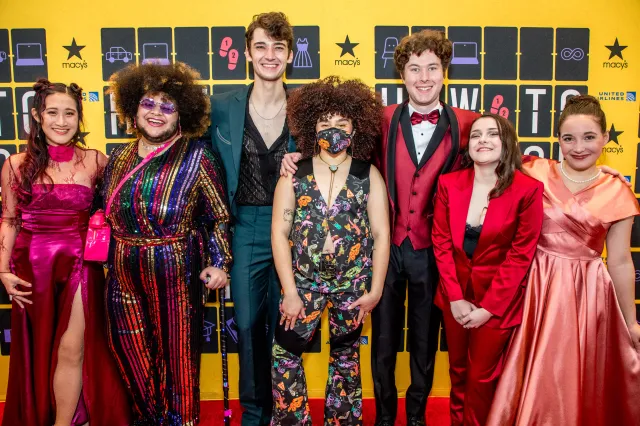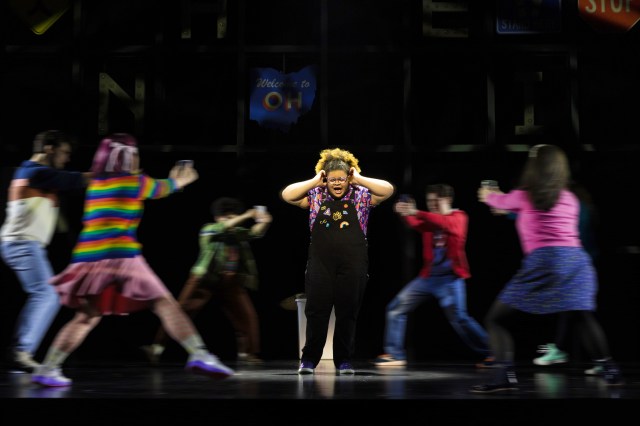How They Made How to Dance in Ohio Accessible for Its Autistic Cast, Crew, and Audiences
Sammi Cannold and Ava Xiao-Lin Rigelhaupt discuss what it took to make the show authentic and accessible.
“If you’ve met one autistic person, you’ve met one autistic person.” These words come near the top of How to Dance in Ohio, a new musical currently on Broadway at the Belasco Theatre. Autistic people have some things in common, but every autistic person experiences autism differently. Creating a welcoming environment that acknowledges all those differences backstage, onstage, and in the audience involves “an endless series of small details that together make up an accessible process,” says director Sammi Cannold.

(© Curtis Brown)
Based on the 2015 documentary of the same name about a group of autistic young adults getting ready for a spring formal dance held by the Amigo Family Counseling Center, How to Dance in Ohio is making history as the first show on Broadway to have autistic leads playing autistic characters. Every autistic character is played by, and understudied by, an autistic actor.
That hasn’t always been the case. The Tony-winning play The Curious Incident of the Dog in the Night-Time, for example, opened on Broadway in 2014, but an autistic actor did not play the lead role until Mickey Rowe was cast in a joint production for Indiana Repertory Theater and Syracuse Stage in 2017.
For Cannold, hiring autistic actors was a given. She has an autistic brother and was used to seeing him be underestimated. “People would say, ‘What will happen if you don’t find who you’re looking for?’ and I said, “Then we won’t do the show.’ I’m not interested in directing something where people are putting on autism,” she says.
She did find the right people — Desmond Luis Edwards as Remy, Amelia Fei as Caroline, Madison Kopec as Marideth, Liam Pearce as Drew, Imani Russell as Mel, Conor Tague as Tommy, and Ashley Wool as Jessica — who have been with the show since before it premiered at Syracuse Stage in September 2022.

(© Tricia Baron)
“What’s happened over those two years is that those characters have become equal parts the people they’re based on from the documentary and equal parts the actual actor who originated the role,” says Cannold, “and as a result of that, there are so many moments in the script where the personal lived experiences of the actor, with the actor’s permission, have gone into the show.”
Authenticity was further helped by autistic creative consultant Ava Xiao-Lin Rigelhaupt, who is neurodivergent and who advised bookwriter and lyricist Rebekah Greer Melocik and composer Jacob Yandura. They discussed autism clichés to avoid, such as autistic people never making eye contact (this is true for some but not all).
Rigelhaupt describes an authentic portrayal of autism as “authentically cast autistic actors playing autistic characters that doesn’t lean into clichés or inspirational porn, which is when a disabled person’s sole existence in a narrative is to make nondisabled people and audiences feel better about themselves.” She adds, “Our show examines the nuances and intricate behaviors, lives, needs, and dreams of autistic people, and I think that’s what makes a great, authentic portrayal of autism.”
Inclusion doesn’t stop at realistic portrayals. Rigelhaupt and others in the show helped develop tools for accessibility. One of the first and most important was a survey given to the company and crew asking about access needs, sensitivities, and essentials for doing their jobs well. The survey was sent out at every iteration of rehearsal.
“Even before entering the space, our actors and crew felt really supported and respected, and simple things like this create more equity and accessibility,” says Rigelhaupt. “The answers that we got back,” says Cannold, “helped us to create a process that allowed everybody to do their best work, not just for autistic company members, but for everybody.”
Survey responses included, for example, smell and noise sensitivities. The surveys also helped Cannold understand the best way to direct. “The answers that I got back from the majority of our autistic company members was that they wanted very clear, specific, concise, well-prepared direction, that it’s in the ambiguity and the openness of some styles of direction that they find difficulty,” she says.
Another piece of feedback was that actors wanted to be able to step out of rehearsals if they felt overwhelmed, and the producers made it possible for the understudies to be in the room so they could step in if an actor had to excuse themself.

(© Curtis Brown)
During tech, Rigelhaupt and the access team were present to make sure the show was as sensory-friendly as possible. There are no loud crashes or strobe lights, and they pointed out that the reflection from a disco ball was going to be difficult for some people with visual sensitivities and asked set designer Robert Brill to dull the reflections. “We recognize that no show can meet 100 percent of every single person in the audience’s sensory needs at any time, so ensuring accessibility support is of utmost importance,” says Rigelhaupt.
To that end, a sensory advisory guide is made available on the show’s website and through a QR code in the program. If audience members do feel overwhelmed and need a break, there are cool-down spaces in the lower lobby and in front of the mezzanine. Sensory bags are available, which include fidgets and other items such as sunglasses in case the lights are too bright. There are also sensory-friendly performances with TDF that offer even more accommodations.
“The show is showing why it’s so important to break open the gates to Broadway a historically gate-kept industry and how impactful it is for people to finally feel welcomed into the audiences and welcomed into the arts as people onstage, behind, et cetera,” Rigelhaupt says. These lessons will have a lasting impact on Cannold, who plans to implement the survey from the rehearsal process for future shows to create safer, more productive rooms. “There’s something called masking that a lot of autistic individuals end up practicing where they mask certain traits of theirs that are commonly thought of as autistic in order to fit in,” she says, adding that even neurotypical individuals mask sometimes. “I think that our room in saying to people, ‘Please unmask and be yourself if you’re comfortable doing that.'”
Though it’s impossible to predict whether other shows will follow How to Dance in Ohio’s lead, there is one way that Cannold thinks the show’s Broadway run will have a long-term impact: “I don’t think anybody is ever going to be able to have an autistic role played by a neurotypical actor ever again because the common response of ‘We can’t find the talent’ is debunked by this process.”








